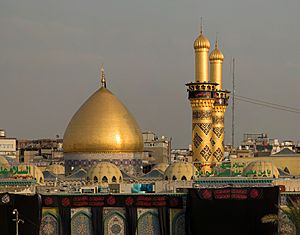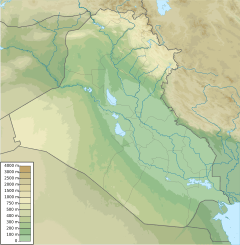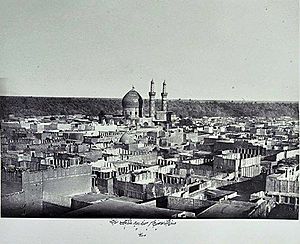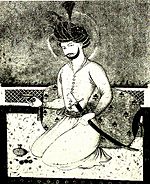Al-Abbas Shrine facts for kids
Quick facts for kids Al-Abbas Shrine |
|
|---|---|
|
Arabic: حَرَم أَبِي ٱلْفَضْل ٱلْعَبَّاس
|
|
 |
|
| Religion | |
| Affiliation | Islam |
| Rite | Shia |
| Ecclesiastical or organisational status | Mosque and shrine |
| Status | Active |
| Location | |
| Location | Karbala |
| Country | Iraq |
| Architecture | |
| Architectural type | Islamic architecture |
| Specifications | |
| Dome(s) | 1 |
| Minaret(s) | 2 |
The Al-Abbas Shrine (Arabic: حَرَم أَبِي ٱلْفَضْل ٱلْعَبَّاس, romanized: Ḥaram ʿAbī al-Faḍl al-ʿAbbās) is a special building in Karbala, Iraq. It is the burial place of Abbas ibn Ali and also a mosque, a place for prayer. It is located very close to the Imam Husayn Mosque.
Abbas ibn Ali was an important figure in Islamic history. He was the son of Ali ibn Abi Talib and the half-brother of Imam Hasan and Imam Husayn. Abbas was known for being Husayn's flag-bearer and leader of his group during the Battle of Karbala.
Many Shia Muslims consider this shrine very holy. Millions of people visit it every year, especially during the month of Muharram.
Interestingly, the Euphrates river has changed its path over many years. Now, about 1,400 years after the Battle of Karbala, the river flows right around Abbas's grave. People say it's as if the Euphrates has come to Abbas.
In recent times, the shrine has been improved a lot. For example, its dome has been re-gilded with gold. Also, the main courtyard has been covered with a roof. This helps to make visits more comfortable for the many pilgrims who come from all over the world.
Contents
History and Design of the Shrine
Over centuries, many rulers have given valuable gifts to the shrine of Al-Abbas ibn Ali. In 1622, Abbas Shah Safavi ordered the dome of the grave to be decorated. He also built a special window around the grave and organized the area around it.
During the time of the Ottoman Empire, the shrine was rebuilt by several Ottoman Sultans. These included Suleiman the Magnificent, Murad III, and Murad IV.
Most of the shrine's current look was created by architects from Persia and Central Asia. The main dome is shaped like a teardrop and is beautifully decorated. It has an inner dome and an outer dome. The inner dome, which you can see from inside, is covered with amazing mirror work.
Two tall towers, called minarets, stand on either side of the dome. These minarets were covered in gold during renovations in 2007. The tomb itself is covered with pure gold and surrounded by a silver fence. Beautiful Iranian carpets are spread out on the floors.
Modern Renovations and Improvements
Since 2012, the Al-Abbas Shrine has been going through big changes. These improvements are meant to help the millions of visitors who come each year. The work includes rebuilding the wall around the shrine. This new wall is becoming a multi-story building. It will have museums, offices, and more prayer rooms.
The dome and minarets have also been re-gilded with gold. The main courtyard, where pilgrims gather, has been covered with a roof. This provides shelter and makes the space more comfortable.
In 2014, work started on a new basement area. This basement is being built under the main courtyard to make even more space for visitors. The project also fixes problems with the shrine's foundation. The foundation has water gaps because part of the Euphrates river flows around Abbas's grave. Once this work is finished, visitors will be able to get closer to the actual grave than ever before.
In March 2016, a new Zarih (a decorative cage or grill) for Abbas's grave was finished. This Zarih is special because it was the first one completely built in Iraq by Iraqi artists. It was officially opened on April 21, 2016.
Timeline of Key Events
Here are some important dates in the history of the Al-Abbas Shrine:
- 680 CE (61 AH): Al-Abbas ibn Ali was buried at this location.
- 1622 CE (1032 AH): Abbas Shah Safavi decorated the dome. He also added glass around the grave and organized the area. He sent precious carpets from Iran.
- 1703 CE (1115 AH): Nadir Shah sent gifts and had the shrine further decorated.
- 1705 CE (1117 AH): Nadir Shah's vizier (a high official) visited. He rebuilt parts of the shrine and added a chandelier.
- 1801 CE (1216 AH): The shrine was damaged and precious items were taken.
- 1817 CE (1232 AH): Fat'h ‘Alī Shāh Qājār rebuilt the dome. He also gave new chandeliers and decorations to the holy shrines.
- 1936 CE (1355 AH): The shrine's caretaker, Sayyid Murtadhā, rebuilt a silver gate. This gate leads to the room where the tomb is.
- 1991 CE (1411 AH): There was an uprising in Karbala after the Gulf War. The shrine suffered some damage.
- 1994 CE (1415 AH): Repairs from the 1991 damage were completed.
- 2004 CE (1425 AH): On March 2, during the Day of Ashura events, there were explosions.
- 2006 CE (1426 AH): On January 5, there were more attacks near the shrine.
- 2007 CE (1428 AH): On April 28, another attack happened as people were going to evening prayers.
- 2008 CE (1429 AH): On September 11, a bomb exploded near the shrine.
- 2012 CE (1434 AH): Construction began on a roof to cover the shrine's courtyard. This was part of efforts to make visits better for pilgrims.
- 2014 CE (1436 AH): In late October, a very large project started. This was the construction of a basement under the main courtyard to make more space for visitors.
- 2016 CE (1438 AH): In April, the new Zarih (the decorative cover over the grave) was put in place. This Zarih was the first one made entirely in Iraq by Iraqi craftspeople.
See also
 In Spanish: Mezquita de Abbás para niños
In Spanish: Mezquita de Abbás para niños
- Abbas ibn Ali
- Arba'een
- Holiest sites in Islam (Shia)
- List of the oldest mosques in the world
- Karbala International Airport





